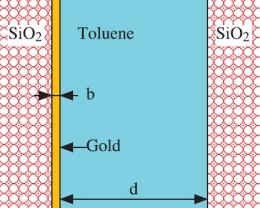There is an attractive Casimir-Lifshitz force between two silica surfaces in a liquid (bromobenze or toluene). We demonstrate that adding an ultrathin (5–50 Å) metallic nanocoating to one of the surfaces results in repulsive Casimir-Lifshitz forces above a critical separation. The onset of such quantum levitation comes at decreasing separations as the film thickness decreases. Remarkably, the effect of retardation can turn attraction into repulsion. From that we explain how an ultrathin metallic coating may prevent nanoelectromechanical systems from crashing together
Two pieces of silica – one with a gold nanocoating – will experience a repulsive Casimir-Lifshitz interaction beyond a critical distance. Without the gold nanocoating, the interaction would be attractive at the same distance. Image credit: Boström, et al. ©2012 American Institute of Physics
Arxiv – Enlarged Molecules from Excited Atoms in Nanochannels (5 pages)
The resonance interaction that takes place in planar nanochannels between pairs of excited state atoms is explored. We consider interactions in channels of silica, zinc oxide and gold. The nanosized channels induce a dramatically different interaction from that in free space. Illustrative calculations for two lithium and cesium atoms, demonstrate that there is a short range repulsion followed by long range attraction. The binding energy is strongest near the surfaces. The size of the enlarged molecule is biggest at the center of the cavity and increases with channel width. Since the interaction is generic, we predict that enlarged molecules are formed in porous structures, and that the molecule size depends on the size of the nanochannels.
If you liked this article, please give it a quick review on ycombinator or StumbleUpon. Thanks

Brian Wang is a Futurist Thought Leader and a popular Science blogger with 1 million readers per month. His blog Nextbigfuture.com is ranked #1 Science News Blog. It covers many disruptive technology and trends including Space, Robotics, Artificial Intelligence, Medicine, Anti-aging Biotechnology, and Nanotechnology.
Known for identifying cutting edge technologies, he is currently a Co-Founder of a startup and fundraiser for high potential early-stage companies. He is the Head of Research for Allocations for deep technology investments and an Angel Investor at Space Angels.
A frequent speaker at corporations, he has been a TEDx speaker, a Singularity University speaker and guest at numerous interviews for radio and podcasts. He is open to public speaking and advising engagements.


